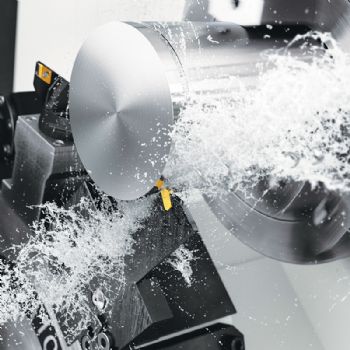
Halesowen-based Sandvik Coromant has unveiled a new blade for its CoroCut QD parting-off system; in combination with new process methodology, this improves the tool’s stability by
“re-aligning the resultant cutting force”.
Among the benefits said
to be available are improved productivity, enhanced surface quality and reduced noise levels. (
www.sandvik.coromant.com)
With conventional parting-off tool configurations, the feed motion in the XZ plane is an inherent limitation, because the resultant vector of the cutting forces is directed sharply across the tool’s cross-section, leading to high loads and potential deformation.
To remedy this situation, Sandvik Coromant has developed a solution that takes advantage of the capability of many modern turning centres and multi-task machines to feed the tool in the Y direction.
With this new concept, the top face of the insert is placed parallel to the end of the blade, as if rotating the insert seat 90deg anti-clockwise.
The new blade cuts its way into the workpiece with its front end, which roughly aligns the resultant vector of cutting forces with the longitudinal axis of the blade.
FEM analysis confirms that this eliminates the critical stresses associated with conventional blades and increases blade stiffness by six times compared with standard designs.
With enhanced stiffness, customers can increase feed rates or use a longer overhang without losing stability.
When used on turning centres, the biggest benefits of Y-axis parting-off are improved productivity and process security.
For multi-task machine users, Y-axis parting-off blades offer increased accessibility and capability for larger diameters.
In fact, tests confirmed a 50% increase in overhang when parting-off a conventional 120mm-diameter bar at the maximum feed capacity of the insert, thus helping to maximise the full potential of the machine.
Furthermore, a 300% productivity increase was achieved without any compromise in process security.
In a customer test case, Y-axis parting-off successfully replaced bandsawing for a 180mm-diameter Inconel bar, resulting in significant productivity improvement due to shorter machining times.
Another advantage of Y-axis parting-off is that it requires minimal changes to typical production set-ups.
Importantly, the same program can be used for all components, while an additional benefit is that practically no extra tool costs are incurred, as existing CoroCut QD tooling can be used.
The new CoroCut QD blades come in widths of 3 and 4mm. Standard-length versions (in both 3 and 4mm widths) are offered for parting-off diameters up to 120mm; there is also an extra-long 4mm-wide blade for parting-off diameters up to 180mm.